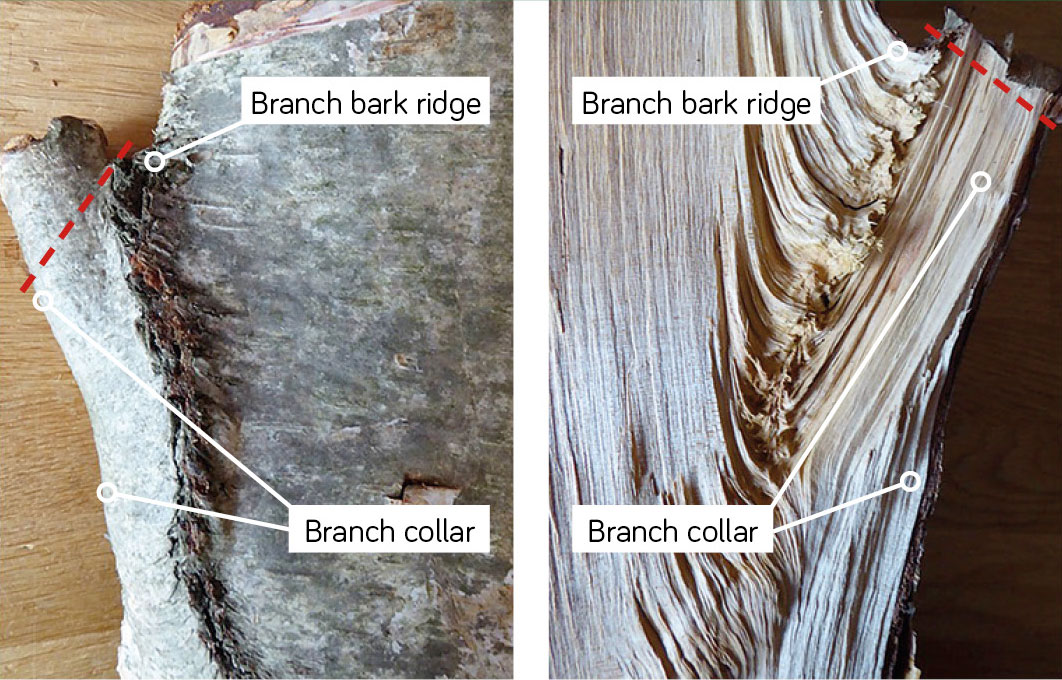Guide to Tree Pruning
Tree Pruning is part of a series of general information leaflets produced by the Arboricultural Association.
The Association provides membership services, accreditation and support to 3,000 professional arborists in the UK and further afield.
We strongly recommend that you use an accredited ARB Approved Contractor or AA Registered Consultant who has been vetted and approved by the Arboricultural Association.
You can find an accredited tree surgeon or consultant though our directories at www.trees.org.uk/Find-a-professional Please note the association is not able to provide direct advice to the general public.
How a tree works
Before we discuss pruning, we need to consider what a tree is and how it works. An appreciation of the processes involved in the growth of tree will help us to understand the principles behind pruning.
A tree is a dynamic living organism that has a self-supporting woody stem. Through the process of photosynthesis the tree converts carbon from the atmosphere into sugars, which it uses to make the building blocks of cellulose and lignin required to sustain its self-supporting structure. The sugars produced are transported throughout the tree via the inner bark area, known as the phloem, to where they are required; sugars not immediately required are stored within the trunk, branches and rooting system.
The tree roots absorb water and other essential nutrients and minerals from the soil, which are then transported to the leaves via tubular vessels called xylem. The minerals, along with the sugars produced via photosynthesis, are used to produce the flower and subsequently fruit to advance the next generation of trees.
Why prune your tree?
There are many reasons why trees might need pruning. These reasons could include improving the structure of the tree, to remove dangerous or defective branches; the reduction of shading, the reduction of wind loading or to provide clearance between the tree and a structure – to name just a few. Care must be taken however, as removing too big a branch can lead to disease entering the tree via the wound/s left behind, or reduce the vitality of tree due to the excessive volume of leaf bearing material being removed.
Before any branch is removed the following questions should be asked:
What will be the result of removing this branch?
Will it leave a large wound?
Will it remove a large area of leaf bearing material?
Will it leave the tree open to an increased risk of disease?
If the questions above can be answered with a “No” then the removal of the branch can proceed. It is very important to realise however, that the removal of tree branches can be a dangerous process and the safest option, particularly if the branch cannot be reached from the ground, is to employ a suitable trained and insured arborist (also known as a tree surgeon). A list of Arboricultural Association ARB Approved Contractors is available on our web site at www.trees.org.uk/Find-a-professional
Figure 1 – Optimum position of the final pruning cut
How to prune a tree
Branches were once buds that became twigs, and over time and incremental growth, have gone on to form a branch. As the tree produces an annual ring of growth, so does the branch, strengthening the attachment of the branch to the tree. This attachment point will sometimes exhibit a strip of raised bark known as a ‘branch bark ridge’ on the top and sides of the branch and a ‘branch collar’, which is the area around the base of the branch.
To keep the wound as small as possible, the British Standard for tree work (BS 3998: 2010 Tree Work – Recommendations) states that the diameter of the final cut should not exceed one third of that of the parent branch or stem.
To remove the branch, a sequence of step cuts should be made with a shallow cut being made first on the underside leading to a top cut outside i.e. past, the underside cut. This will reduce the risk of the branch tearing down the stem and leaving an unsightly and potentially damaging wound; the final pruning cut can then be made at the branch bark ridge and branch collar.
When removing a branch, the final cut should be made from the branch bark ridge to the branch collar, along the red dotted line in figure 1. By following the imaginary red dotted line, the size of wound, in relation to the parent stem, will be left as small as possible. Some branches do not form a distinct branch collar, where this occurs, the cut should be made so as not to damage the branch bark ridge whilst leaving a small diameter wound.
If a large diameter branch is removed, the risk of disease entering the wound increases. Certain fungi and bacteria can enter the tree via these wounds and cause the woody structure of the tree to decay. Although decay is a normal process in terms of a trees life cycle, advancing this process by incorrect pruning can have serious consequences by compromising the health and structural integrity of the tree.
When to prune
If the decision has been made to prune or remove a branch, then a decision has to be made when to carry out the work. Pruning should generally occur after the leaves have ‘flushed’ and hardened, so late spring through summer. There are some exceptions, however, as some species such as Birch, Walnut and Maples, will ‘bleed’ sap and risk losing valuable sugars in the process if pruned in early spring, therefore the pruning of these trees should be carried out when this risk is low i.e. summer or mid winter.
Species belonging to the genus Prunus such as Cherry partially rely on the production of a resin or gum to aid in the defence against wound related pathogens, therefore pruning should occur in the summer. In general, pruning should avoid periods where the exposed wood will be left open to severe conditions such as drought, frost, and periods of fungal sporulation (autumn). Table 1 below gives the appropriate time to prune for a number of species commonly planted or found growing naturally within the United Kingdom and Northern Ireland and also indicates species specific tolerance to pruning. It should be noted that in most circumstances, unless there is a potentially hazardous structural defect that needs to be addressed, it is always best to prune trees as little as possible, as removing large amounts of wood and foliage reduces the ability of the tree to photosynthesise and can put the tree under significant stress.
Please note: Trees may be legally protected and unauthorised work can lead to prosecution. It is also your responsibility to ensure that protected wildlife is not harmed. Further advice can be found on our website at www.trees.org.uk/Help-and-Advice
| Species | Tolerance to hard pruning Good, Fair or Poor | Optimum time to prune | Notes |
|---|---|---|---|
| Deciduous trees | |||
| Acacia | Fair | Spring (late) | Living wood most obvious, dead can be easily identified |
| Ailanthus | Fair | Spring (late) to summer | |
| Alder | Fair | Spring (late) to summer | |
| Apple | Good | Winter (mid) | Prune every year for fruit production |
| Ash | Fair | Spring (late) to summer | |
| Beech | Poor | Spring (late) to summer | |
| Birch | Poor | Summer or winter (mid) | Prone to bleeding |
| Cherry (& other Prunus sp. e.g. Almond, Apricot, Peach, Plum) and Silver leaf. Avoid fungal sporulation period (autumn) | Fair | Summer | Prone to drought, frost damage |
| Elm | Good | Spring (late) to summer | |
| Eucalyptus | Poor | Spring (late) to summer | |
| Hornbeam | Poor | Spring (late) to summer | |
| Horse Chestnut | Good | Spring (late) to summer | Avoid if possible as regrowth is weak and heartwood is quick to decay |
| Lime | Good | Spring (late) to summer | |
| Magnolia | Fair | Summer (mid) | Reduces bleeding and allows time for healing to begin |
| Maples (inc Sycamore) | Fair | Summer or winter (mid) | Prone to bleeding (Field maple less susceptible) |
| Mulberry | Good | Winter (mid) | |
| Oak | Good | Spring (late)to summer | |
| Plane | Good | Spring (late)to summer | |
| Poplar | Good | Winter (mid) | Prone to bleeding |
| Robinia | Good | Summer (mid to late) | Prone to bleeding |
| Rowan | Fair | Spring (late) to summer | |
| Walnut | Poor | Summer or winter (mid) | Prone to bleeding |
| Whitebeam | Poor | Spring (late) to summer | |
| Willow | Good | Spring (late) to summer | |
| Evergreen trees | |||
| Cedars | Poor | Winter (mid to late) | Avoid any pruning if possible. Shoots will not grow from old wood – therefore prune lightly. |
| Cypresses | Poor | Spring (late) to summer (early) | Shoots will not grow from old wood – therefore prune lightly |
| Firs | Poor | Summer (late) or winter (late) | Avoid any pruning if possible. Shoots will not grow from old wood – therefore prune lightly |
| Hemlock | Fair | Summer (late) or winter (late) | |
| Holly | Fair | Winter (mid to late) | |
| Holm oak | Poor | Winter (mid to late) | |
| Pines | Poor | Spring (late) | Avoid any pruning if possible as buds only at shoot tips. Newest growth can be removed during the spring |
| Spruce | Poor | Summer (late) or winter (late) | Shoots will not grow from old wood – therefore prune lightly |
| Western red cedar | Fair | Winter (mid to late) | |
| Yew | Fair | Summer (late) or winter (late) |
